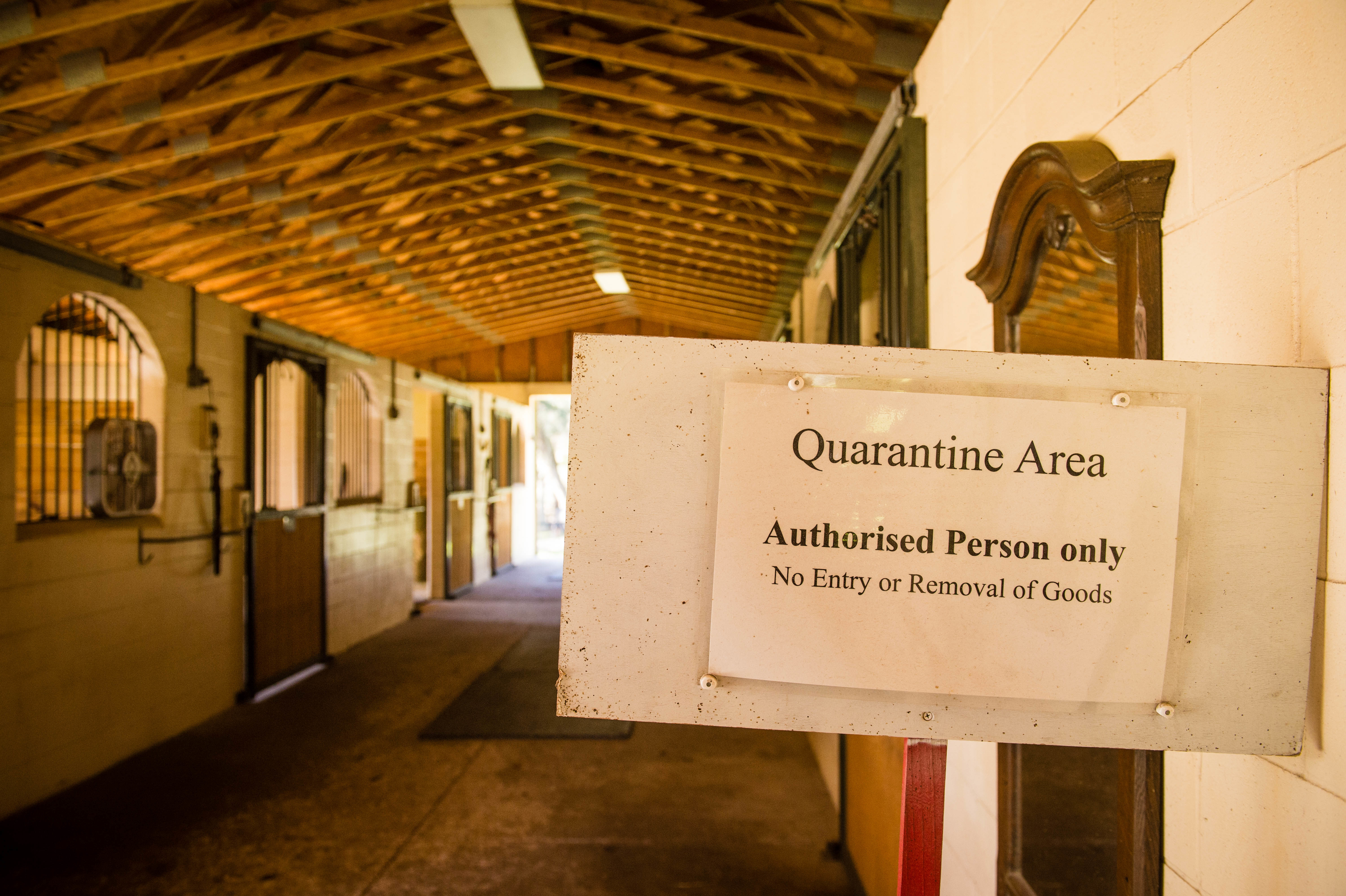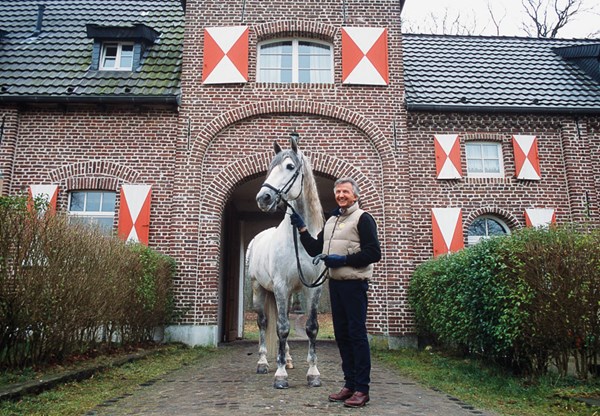Show season is quickly ramping up across the country and so are the reports of serious equine-disease outbreaks: strangles in Florida, influenza in Arizona and Georgia, equine herpes virus (EHV-1) in six different states. But there are plenty of measures you can take to reduce the risk of invisible disease dangers.

Here are 10 reminders for how to help keep your horse safe at shows:
1. Vaccinate Before You Show
Long before heading out to the first show of the season, start your effective biosecurity strategy at home. It should include vaccine protection against the three diseases most common at horse shows: influenza, rhinopneumonitis and strangles. Some vaccines work better than others and even regular vaccination may not prevent a disease entirely, but at the very least, they tend to lessen the effect of the disease if it manifests itself in the horse. Also, competitors should be aware that the USEF now has rules in place mandating that all horses entering the grounds of a federation-licensed competition must be accompanied by documentation of vaccinations within six months prior to entering the stables (visit usef.org for more information).
2. Know Your Stall Situation
A common sight at shows is stabling with open bars and grills between horses, most often seen in the wall panels of temporary stabling. But this open design is a biosecurity nightmare: Open-sided stalls allow disease to pass through an entire barn via nose-to-nose contact between horses coming from different farms and backgrounds. If possible, request stalls with solid walls high enough so that horses can’t touch noses over the top and without any gaps or cracks in the walls. If open-sided stalls are unavoidable, consider requesting a stall on an end or outside wall or with a tack stall as separation between horses or even consider covering open walls with carefully-secured tarps.
3. Wait Just a Minute
Upon arrival at the showgrounds, competitors are often eager to unload horses and equipment as soon as possible after a long trailer ride. But there’s no way to know if the stall you’ve been assigned was used last week by a hunter from another state who happened to have a case of strangles and that disease’s unseen pathogens are not only waiting to find a new host in your horse, but are also happy to hitch a ride home and infect stablemates. Even more alarming, many disease agents in saliva and respiratory secretions can remain in the dirt floors and on barn surfaces, such as walls and doors, for extended periods of time. A key to disease control is cleanliness, and for best results, all surfaces, such as stall walls and the floor, should be free of dirt and organic matter like manure. Simply cleaning the stall walls using a soapy sponge with laundry detergent and water can make a big difference in reducing risk and takes only a few extra minutes upon arrival at the show.
4. Take It One Step Further
For even better protection, the stall should also be disinfected, which can easily be accomplished with a small hand-pump garden sprayer. A variety of disinfecting-solution options exist, from basic Pine-Sol to high-tech industrial products, but different classes of disinfectants work very differently and not all are suitable for agricultural application. Research products ahead of time and ask your veterinarian or local equine veterinary hospital for recommendations. Whatever you choose, be sure to follow label directions regarding dilution rate, application method, whether rinsing is required and the amount of drying time needed before a product has killed any organisms that may be present and any residue is safe for a horse to come in contact with. While washing and spraying, take the opportunity to thoroughly inspect the stall area for loose nails, debris and any other dangers to your horse’s physical safety.
5. Don’t Share
Take care not to share equipment and tools with others. If this is unavoidable, ideally the equipment should be scrubbed with detergent and allowed to dry completely. Use only your own feed and water buckets, label them with each horse’s name and don’t use them for any other horse to avoid cross-contamination. Use special caution with water sources: Don’t fill buckets or allow a horse to drink from a communal water tank, and always use your own hose. If a shared hose cannot be avoided, do not submerge the end or nozzle in your horse’s bucket: Alarmingly, one of the easiest conduits for strangles to move from stall to stall is through a shared water hose.
6. Keep Some Distance
In addition to great sporting competition, horse shows are known to be social occasions, but even the most innocent and friendly interactions can present a danger to your horse’s health. Stay on the safe side: avoid strangers and keep your horse a safe distance away from others. Don’t allow him to touch noses with other horses and avoid grazing in common areas. And just as you do during cold and flu season, wash your hands frequently and consider carrying handy disinfectant gel or wipes to use not only for your hands, but also on surfaces you often touch (such as door handles, stall latches, water faucets, etc.).
7. Protect the Home Front
The practice of proper biosecurity measures shouldn’t stop when you and your horse are safely home from a show. Any horse who has been in a public environment can pick up a pathogen and incubate an illness for several days without showing any outward symptoms. Even more nefarious are horses who become “shedders” of a virus or bacteria, infecting others without ever showing any signs of the disease themselves. Ideally, every horse who goes to a show should be segregated (or at least moved to an end stall) from others for at least a week. After a competition, monitor horses for any developing signs of illness such as a cough, nasal discharge, lethargy, decreased appetite or elevated temperature, and be sure to wash all clothes and equipment before coming in contact with other horses.
8. Avoid Risks on the Road
While the risk of transmission of disease due to transport is likely quite low for competitors who only haul their own horses to shows, extra precautions should be taken when using a commercial shipper or even when hauling with friends. Again, cleanliness is key, especially when it comes to using a shipper: Reputable companies clean their trucks and trailers regularly and disinfect all surfaces, including buckets and haynets, as well as require health papers for all equine passengers. Even if you’re just hauling to a local show with a friend, it’s always better to be safe than sorry: Everyone’s horses should be fully vaccinated, the trailer should be clean and don’t go if a horse has a cough, fever or nasal discharge.
9. Stay Informed
Knowledge is power, and keeping up with what’s going on out there starts with your own veterinarian. While these days news can travel around the world in an instant, don’t rely solely on social media, which can distribute false reports as quickly as credible information. Instead, utilize official sources such as the Equine Disease Communication Center website (equinediseasecc.org), which includes easy-to-use navigation for horse owners with resource pages for reported outbreaks, contact information for state veterinarian’s offices, a library of equine diseases, vaccination information and biosecurity practices. Horse owners can easily look up or report issues in any area across the country, including where they may be traveling for a horse show.
10. Denial Doesn’t Work
The spread of equine disease can happen anytime and anywhere, from small local shows to large national championships. Major international events, such as the Olympics and World Equestrian Games, are famous for utilizing incredibly intense health protocols to protect equine athletes, but, unfortunately, many horse owners maintain an attitude that “It can’t happen to me” when it comes to biosecurity. But besides the obvious health risk, even a short-term illness can disrupt training trajectories and show campaigns, and if an incident occurs in a commercial boarding or training barn, the effects on a professional’s business can be anything from a minor inconvenience to devastating. Remember, while participation in public horse shows will always involve things that are completely out of one’s control, there are plenty of measures that owners can easily do to reduce risk to their horses’ health, and a few extra minutes and effort can make all the difference.











